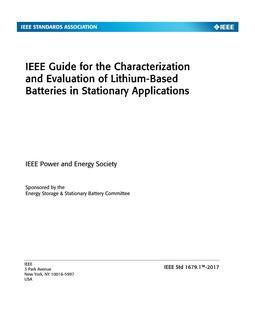Full Description
Scope
This document provides guidance for an objective evaluation of lithium-based energy storage technologies by a potential user for any stationary application. This document is to be used in conjunction with IEEE Std 1679¿¿¿-2010, IEEE Recommended Practice for the Characterization and Evaluation of Emerging Energy Storage Technologies in Stationary Applications.For the purposes of this document, lithium-based batteries include those secondary (rechargeable) electrochemistries with lithium ions as the active species exchanged between the electrodes during charging and discharging. Examples of secondary lithium-based batteries are lithium-ion, lithium-ion polymer, lithium-metal polymer, and lithium-sulfur batteries. Primary (non-rechargeable) lithium batteries are beyond the scope of this document.While this document does not cover lithium-based batteries used in mobile applications, the information provided is applicable to electric vehicle or similar batteries that are repurposed for use in stationary applications. This document also applies to batteries that are stationary when in operation but are intended to be relocated, for example, containerized or trailer-mounted systems.The outline of IEEE Std 1679-2010 is followed in this document, with tutorial information specific to lithium-based batteries provided as appropriate. Examples of tutorial information include technology descriptions, operating parameters, failure modes, safety information, battery architecture, and qualification and application considerations.This document does not cover sizing, installation, maintenance, and testing techniques, except insofar as they may influence the evaluation of a lithium-based battery for its intended application.
Purpose
Lithium-based batteries have been used in various, non-stationary applications for many years. They are now beginning to be used in stationary applications and, as such, there is a need to provide appropriate information on safety and operating conditions related to these applications. End-users would benefit from having a guide to assist in evaluation of this technology for stationary applications. Used with IEEE Std 1679-2010, this guide describes a format for the characterization of lithium-based battery technologies in terms of performance, service life, and safety attributes. This format will provide a framework for developers and manufacturers to describe their products. The resulting information will assist users, integrators, and servicing organizations in evaluating the possible use of these batteries in stationary applications and to provide objective criteria for comparative evaluation.
Abstract
New IEEE Standard - Active.Guidance for an objective evaluation of lithium-based energy storage technologies by a potential user for any stationary application is provided in this document. IEEE Std 1679-2010, IEEE Recommended Practice for the Characterization and Evaluation of Emerging Energy Storage Technologies in Stationary Applications is to be used in conjunction with this document. Secondary (rechargeable) electro-chemistries with lithium ions as the active species exchanged between the electrodes during charging and discharging are included in the category of lithium-based batteries for the purposes of this document. Lithium-ion, lithium-ion polymer, lithium-metal polymer, and lithium-sulfur batteries are examples of secondary lithium-based batteries. Primary (non-rechargeable) lithium batteries are beyond the scope of this document. A technology description, information on aging and failure modes, a discussion on safety issues, evaluation techniques, and regulatory issues are provided in this document. Sizing, installation, maintenance, and testing techniques are not covered, except insofar as they may influence the evaluation of a lithium-based battery for its intended application.
 View larger
View larger  View larger
View larger 
